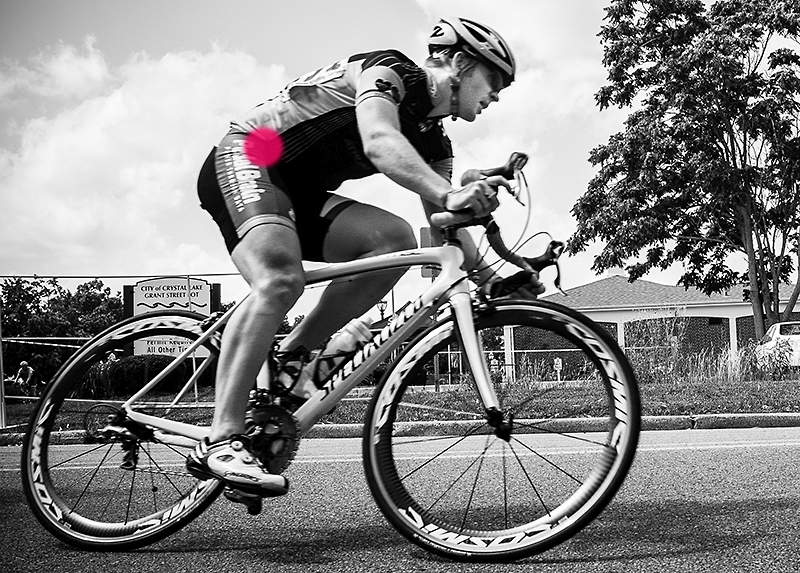You are viewing 1 of your 1 free articles. For unlimited access take a risk-free trial
Spinning the cranks: why hip strength matters

If you’re a cyclist trying to develop strength for the forthcoming season, you shouldn’t overlook training your hip flexor muscles. Andrew Hamilton explains
One of the first things that you learn as an improving cyclist is to ‘think circles’ when spinning the cranks. The reason is simple: by applying effort right through the 360 degrees of crank rotation, you can distribute the total workload across more muscle groups. Spreading the load more evenly means that each individual muscle group has to perform less work and becomes less fatigued. For example, concentrating mainly on the ‘pushing forward and down’ phase of the pedal stroke (common in many inexperienced cyclists) means that nearly all of the work has to be performed by the quadriceps of the frontal thigh and gluteals of the buttocks. However, pedalling in smooth circles (ie applying force as you pull the cranks back and upwards as well) brings the hamstrings of the rear thigh and hip flexor muscles into play, thereby alleviating some of the load on the quads and gluteals.Improving circular strength
Most strength programmes for cycling muscles tend to emphasise the muscles of the buttocks and rear thigh, and if you’re currently training at the gym in readiness for the 2019 season, that’s probably what you’re doing. But given the above, an intriguing question is whether overall pedalling efficiency can be improved by targeting other (and generally overlooked) muscle groups such as the hip flexors (see figure 1), which are heavily involved in the upwards phase of the pedalling circle?Figure 1: The hip flexor muscles

The hip flexor muscles (shown here in the stretched position) act to raise the thigh by flexing the hip (ie bringing the knee closer to the torso).
To test this theory, Danish scientists have looked at whether heavy strength training, including hip flexor training, can reduce the extent of the phase in the crank revolution where ‘negative’ or ‘retarding’ crank torque occurs(1). Negative torque - more commonly known as the ‘dead spot’ - normally occurs in the upstroke phase, where the thigh is lifted up by flexing the hip. In the study, 18 well-trained cyclists were split into two groups:
- The strength-training group performed twelve weeks of heavy strength training in addition to their usual endurance training. This additional strength training consisted of 3 sets (using heavy weights) of four lower body exercises (including hip flexor strengthening).
- The endurance-only group merely continued their usual endurance training and performed no strength work.
A stronger circle
The results showed that the additional strength training performed by the strength group boosted performance in the 5-minute time trial by 7% - significantly more than the endurance-only group. However, what was even more intriguing were the findings on the actual forces applied to the cranks; the researchers found that the cyclists performing the strength work shortened the phase where negative crank torque occurred by around 15 degrees of rotation. In other words the ‘dead spot’ in the 360-degree crank revolution was significantly diminished.Advice for cyclists
A number of recent studies have shown that strength training can significantly boost cycling performance and this one is no exception. What this study also shows however is that including hip flexor work in your strength programme can enhance your ability to spin the cranks smoothly and evenly – an essential ability for cyclists seeking maximum performance and efficiency!Reference
- Int J Sports Physiol Perform. 2012 Dec;7(4):313-21
Newsletter Sign Up
Testimonials
Dr. Alexandra Fandetti-Robin, Back & Body Chiropractic
Elspeth Cowell MSCh DpodM SRCh HCPC reg
William Hunter, Nuffield Health
Newsletter Sign Up
Coaches Testimonials
Dr. Alexandra Fandetti-Robin, Back & Body Chiropractic
Elspeth Cowell MSCh DpodM SRCh HCPC reg
William Hunter, Nuffield Health
Keep up with latest sports science research and apply it to maximize performance
Today you have the chance to join a group of athletes, and sports coaches/trainers who all have something special in common...
They use the latest research to improve performance for themselves and their clients - both athletes and sports teams - with help from global specialists in the fields of sports science, sports medicine and sports psychology.
They do this by reading Sports Performance Bulletin, an easy-to-digest but serious-minded journal dedicated to high performance sports. SPB offers a wealth of information and insight into the latest research, in an easily-accessible and understood format, along with a wealth of practical recommendations.
*includes 3 coaching manuals
Get Inspired
All the latest techniques and approaches
Sports Performance Bulletin helps dedicated endurance athletes improve their performance. Sense-checking the latest sports science research, and sourcing evidence and case studies to support findings, Sports Performance Bulletin turns proven insights into easily digestible practical advice. Supporting athletes, coaches and professionals who wish to ensure their guidance and programmes are kept right up to date and based on credible science.













